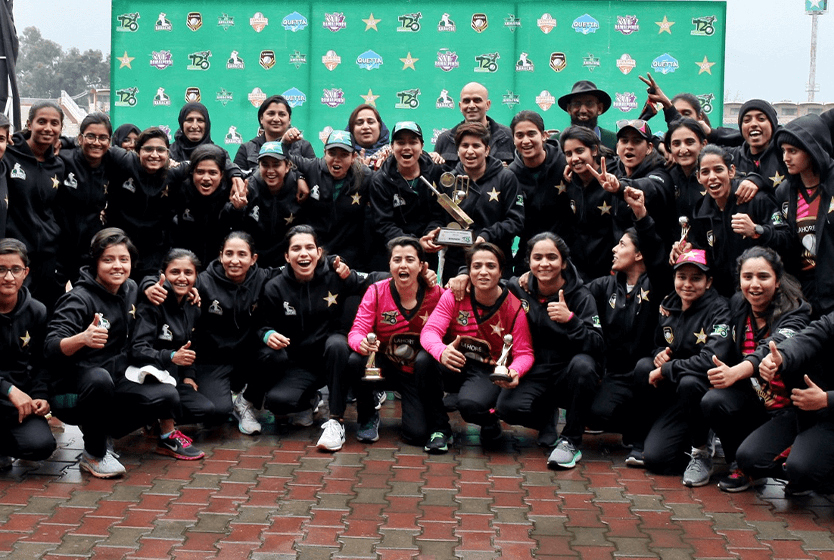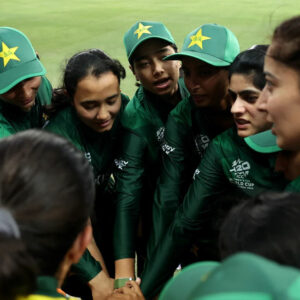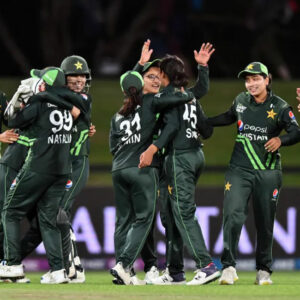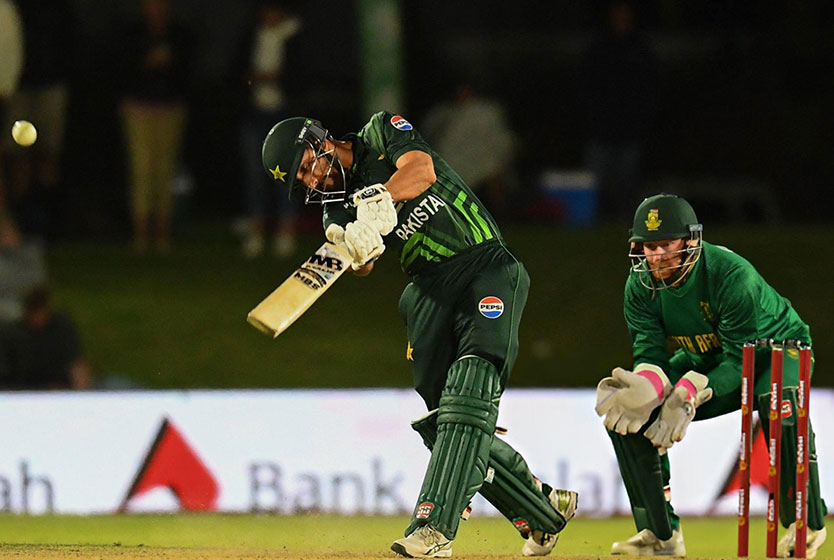
About the Inaugural NWT20, First of Her Name and Burdened With Glorious Purpose
The first edition of the National Women’s T20 Tournament 2023/24 (NWT20) ended last week on a damp and rather underwhelming note. After a largely exciting and competitive round-robin group stage, there were no semi-finals or knockouts, and thus little hope for the mid-table teams to progress past the group stage – though Rawalpindi and Multan did well to give complacent Karachi the fright of their life.
On their road to the final, Lahore breezed their way through the matches with no losses and 10 convincing wins, out of which only 3 went down to the wire. Meanwhile, Karachi edged their way in on NRR after losing 2 out of 2 games to Lahore – both of which they could’ve won but didn’t – and also conceding 1 loss each to Rawalpindi and fifth-placed Quetta.
I say the NWT20 ended on a “damp” note because host city Rawalpindi poured on the day of the final. With no reserve day, the trophy was shared by Karachi and Lahore. The trophy-sharing, if I’m honest, made little sense, considering Lahore was a whopping 8 points ahead on the table, had more than double Karachi’s NRR, and hadn’t broken a sweat in most games, but I’m afraid I’m close to the standard limit of PCB criticism, so I’ll refrain. Also, I am a Fatima Sana fan first, a Karachi-dweller second, and a women’s cricket journalist only third, so I’ll let that slide.
Though no fan or journalist will complain about the 10 glorious group-stage games given to each regional team and the six(!) teams fielded, the tournament format left much to be desired.
In fact, it was because there were so many teams and so many group-stage games this time around that the tournament seemed like it ended when it was just beginning to get interesting.
Multan’s Gul Feroza and her band of talented, driven, uncapped bowlers deserved to play a semi-final or an eliminator after beating Quetta and Peshawar convincingly and then beating Rawalpindi as well.
And Rawalpindi, brave, fast-scoring Rawalpindi, led by Aliya Riaz – who batted at any number, bowled any over, and broke records like they were nothing – deserved to compete for the final.
Instead, Lahore and Karachi made it through, and while only a fool (or someone who doesn’t know Lahore’s depth in women’s cricket) would question their place in the final, plenty can be said about how Karachi made it through only on NRR. And you know us Pakistanis, we have a long history of beef with NRR.
But I digress.
The group-stage games were spectacular. Two weeks in, we saw storylines begin to form, especially in the teams that were more makeshift and felt haphazardly assembled. While Lahore rocked up to every match and rolled over opponents as if it was child’s play with centuries and 5-wicket hauls that were good enough reasons to initially tune in, the other teams gave us reasons to keep watching and tune in again.
For example, Gul Feroza-led Multan’s shallow but determined batting lineup were ensuring their bowlers’ efforts to restrict opponents to small totals did not go in vain. After losing their experienced captain Umme Hani to an unlucky finger injury, they found a reliable bowler in young, inexperienced, but spirited Noor-ul-Iman.
Karachi were struggling to finish close games versus the top teams and realizing they had to speed up their wins against the weaker ones in fear of Multan and Rawalpindi hot on their tail. 20-year-old Aroob Shah’s cameos and veteran Javeria Khan’s measured approach proved especially useful then.
Rawalpindi’s young Aima Saleem was giving her team rapid starts in the Powerplay and all but sacrificing her wicket, knowing that her captain needed her to hit out or get out, that Natalia and Aliya would see them through after her cameos. Meanwhile, Waheeda Akhter guaranteed the team consistently inexpensive and sometimes wicket-taking starts with the bowling, leading the pace attack like the senior player we expect her to be.
And we cannot forget Quetta’s Tuba Hassan, Dua Majid, and Fareeha Mehmood, #5, #6, and #7 on the list of top run-scorers (no other Quetta batter made the top 20). Tuba struck at 143.6 SR, Dua at 93.7, and Fareeha at 91.1 – perhaps this gives their storyline away. Their success relied on Fareeha and Dua batting out the innings, though their tempos varied across phases, and then new-found middle-order sensation Tuba Hassan would explode in the middle and death overs. Despite just 3 wins at the end, these three were an integral part of a recipe for success, a recipe that will be bolstered in the years to come, I hope.
And Peshawar, with 0 wins and 10 losses and the record of the lowest total scored and highest total conceded, had a story, too. It would’ve been easy to see the end of the group stage as a goodbye to Peshawar. It would be easy to write off their run as one to forget. But with no capped players and just three domestic contracted players, Peshawar made the best of what they had. I am certain we’ll be seeing allrounder Momina Riyasat, captain Aleena Shah, 16-year-old Raahima Syed, and a few other of Peshawar’s emerging players again. Even though they ended their run with a massive loss to Lahore, they looked like a better side than their first match.
That’s what domestic cricket does when it’s done right. And even with no final and semi-finals, the 30 group games represented domestic cricket finally done right in Pakistan women’s cricket. It wasn’t exactly the tournament I dreamed of – that one would’ve had more “upsets,” more close games, more runs for Muneeba Ali, actual knockout games, reserve days, the U19 players involved, and perhaps a happy-crying Aliya Riaz holding the winning trophy at the end – but it was the closest we got to perfect in the last five years. For reference, last year’s T20 tournament had a grand total of 6 matches, and this one, even with no KOs and the final washed out, had 30 completed matches.
So, there’s a lot to be grateful for and a lot to look forward to for next year and the year after that and the year after that… unless, of course, the new incoming PCB management decides to forget women’s cricket exists. But we’ll deal with that if it happens.
For now, let’s look at the table and some numbers.
Of course, Lahore is well ahead on pretty much every metric. But I thought it was interesting to see how close Karachi and Rawalpindi really were, with Karachi ahead on bowling economy rate but Pindi edging out on batting run-rate.
While the last four columns only really show how ridiculously good Lahore was as a team compared to the rest, I thought those were fun things to keep track of – things that will hopefully be useful for comparisons in the future when we review the next few NWT20s to see if the standard of T20 cricket has improved. It’s not fair for me to compare run rates from this 30-team tournament to run rates from the 6 or 10-match tournaments we’ve seen for the past six years, but hopefully, we will see this 6-team, double-round-robin tournament again – or a better version of it – so these numbers will all be more useful then.
For now, just see that Quetta scored 140+ twice with their team of 3 batters and 8 other players, ooh and aah with me, but I’d recommend you don’t read too much into it this year.
Instead, wonder with me if the regional academies and stakeholders that feed these six teams will now want to do more for women’s cricket.
Will those who are behind the massive continued successes of KP and Peshawar’s men’s teams now look to women’s cricket and work on the pipeline there?
Will Multan and Quetta’s teams’ stakeholders take the potential they saw in the NWT20 and run with it?
Will those who feed Rawalpindi and Karachi’s teams now vow to never let Lahore’s team walk over them again and lay the groundwork to challenge them for the top spot instead of resigning to being number 2?
There is no shortage of talent or girls and women who love cricket in Pakistan. They just need opportunities, support, the right kind of backing, and exposure. The PCB has done their bit by starting the 6-team, double-round-robin tournament, which will hopefully be continued and developed further every year. The fans have done their bit by following along, making edits, writing posts, and celebrating every run and wicket. Now, it’s time for the third stakeholder to come into play.









Leave a Reply